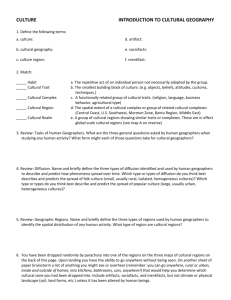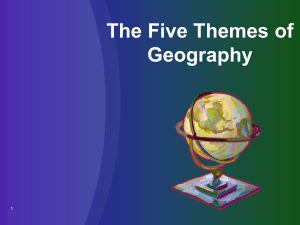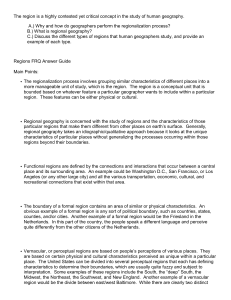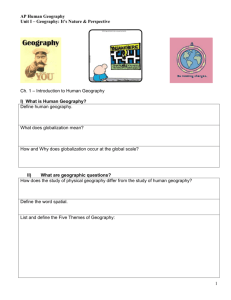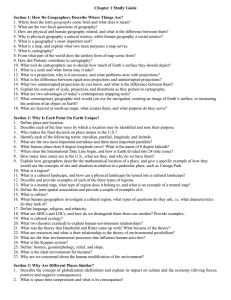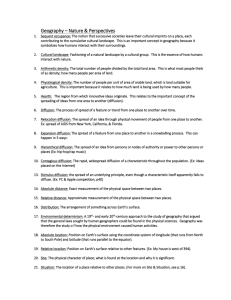Chapter 1 cont. Lecture Notes
advertisement
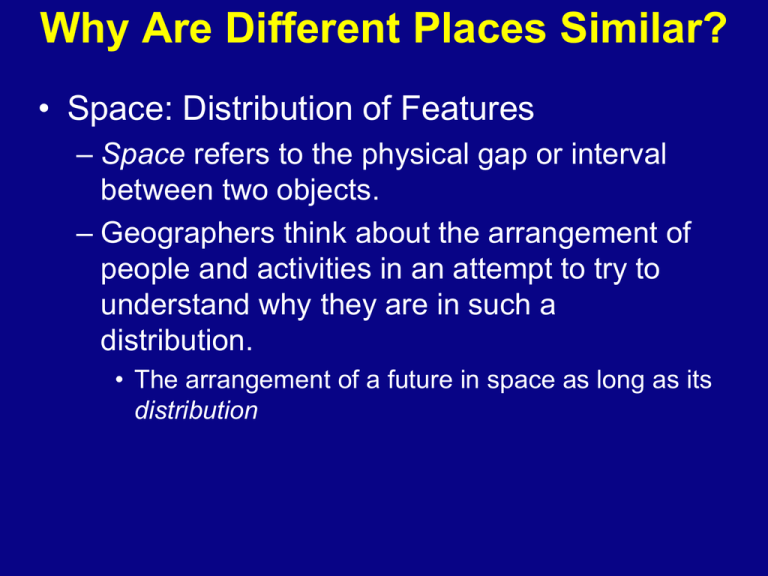
Why Are Different Places Similar? • Space: Distribution of Features – Space refers to the physical gap or interval between two objects. – Geographers think about the arrangement of people and activities in an attempt to try to understand why they are in such a distribution. • The arrangement of a future in space as long as its distribution Why Are Different Places Similar? • Space: Distribution of Features – Geographers identify three main properties of distribution across Earth. 1. Density- frequency with which something occurs in space – Involves the number of a feature and the land area 2. Concentration- extent of a feature’s spread over space – Closely spaced together is known as clustered. – Relatively far apart is known as dispersed. 3. Pattern- geometric arrangement of objects in space Figure 1-24 DISTRIBUTION OF HOUSES The top plan for a residential area has a lower density than the middle plan (24 houses compared to 32 houses on the same 82-acre piece of land), but both have dispersed concentrations. The middle and lower plans have the same density (32 houses on 82 acres), but the distribution of houses is more clustered in the lower plan. The lower plan has shared open space, whereas the middle plan provides a larger, private yard surrounding each house. FIGURE 1-25 DISTRIBUTION OF BASEBALL TEAMS The changing distribution of North American baseball teams illustrates the difference between density and concentration. FIGURE 1-26 PATTERN: TOWNSHIP AND RANGE (left) To facilitate the numbering of townships, the U.S. Land Ordinance of 1785 designated several north–south lines as principal meridians and several east–west lines as base lines. (right) As territory farther west was settled, additional lines were delineated. Townships are typically 6 miles by 6 miles. Why Are Different Places Similar? • Cultural Identity in Space – Patterns in space vary according to gender, ethnicity, sexuality. – The cultural landscape has the ability to communicate to people what the accepted norm is within a place. • Ex. A bar or park that makes whites feel welcomed and people of color unwelcomed (or vice versa) • Ex. An inviting shopping district to people practicing alternative lifestyles located in close proximity to where many same-sex couples live FIGURE 1-28 CONCENTRATION OF GAYS IN THE UNITED STATES FIGURE 1-29 GAY-ORIENTED BUSINESSES IN PARIS In Paris, 140 businesses appealing primarily to gays were identified through four 2004 guidebooks for gay travelers and residents. Gay-oriented businesses were found to be highly clustered in the Marais district of central Paris. Why Are Different Places Similar? • Cultural Identity in Space – Branches of geography seek to better understand the dynamics of gender, ethnicity, and sexuality by looking at the matter through different lenses. • Behavioral geography is a branch of human geography that attempts to understand the psychological basis for individual human actions. • Humanistic geography is a branch of human geography that emphasizes the different ways that individuals perceive their surrounding environment. • Poststructuralist geography emphasizes the need to understand multiple perspectives regarding space. FIGURE 1-30 SEXUAL DIVERSITY IN SPACE The International Lesbian, Gay, Bisexual, Trans and Intersex Association maps the distribution of laws that discriminate on the basis of gender. The harshest laws against male–male or female–female relationships are found in sub-Saharan Africa and Southwest Asia and North Africa. Laws supporting male–male or female–female marriage or equivalent substitute are found primarily in Europe and Latin America. Why Are Different Places Similar? • Connections between Places – People, ideas, and objects move via connections through one of three types of diffusion. 1. Relocation Diffusion – Spread of an idea through physical movement of people from one place to another » Ex. Language brought to a new locale by a migrant 2. Expansion Diffusion – Spread the feature from one place to another in an additive process » Hierarchical diffusion: spread of an idea from persons or nodes of authority or power to other persons or places » Contagious diffusion: rapid, widespread diffusion of a characteristic throughout the population » Stimulus Diffusion: spread of an underlying principle even though a characteristic itself apparently fails to diffuse. Why Are Different Places Similar? • Spatial Interaction – The farther away someone is from you, the less likely you two are to interact. • Trailing-off phenomenon of diminishing contact with the increase in distance is called distance decay. – Electronic communications have almost removed barriers to interaction between people who are far apart. • Access to the technology is of interest to geographers. – – Core: North America, Western Europe, and Japan Periphery: Africa, Asia, and Latin America FIGURE 1-34 SPACE-TIME COMPRESSION Transportation improvements have shrunk the world. FIGURE 1-35 INCOME GAP BETWEEN RICH AND POOR COUNTRIES Income has increased much more rapidly in developed countries than in developing ones. Why Are Some Human Actions Not Sustainable? • Sustainability and Resources – Geographers observe two major misuses of resources: • Humans deplete nonrenewable resources. • Humans destroyed otherwise renewable resources through pollution of air, water, and soil. – Three Pillars of Sustainability 1. Environment Pillar – Sustainable development can only exist if conservation is embraced more fully than wasting resources or preservation of all resources. Why Are Some Human Actions Not Sustainable? • Sustainability and Resources – Three Pillars of Sustainability 2. Economy Pillar – Efforts to set prices of commodities and goods based not only on supply and demand but also on costs to the environment. 3. Society Pillar – Modifying the wants of cultures in regards to shelter, food, and clothing to objects that are sustainable Why Are Some Human Actions Not Sustainable? • Earth’s Physical Systems – Geographers classify natural resources as part of four interrelated symptoms. • Abiotic system is one composed of nonliving or inorganic matter. – Atmosphere: thin layer of gas surrounding Earth – Hydrosphere: all water on and near Earth’s surface – Lithosphere: Earth’s crust and layer just below the crust • Biotic system is one composed of living organisms. – Biosphere: all living organisms on Earth FIGURE 1-39 WORLD CLIMATE REGIONS According to Vladimir Köppen. Climatic Factors • • • • • • Latitude – Earth/sun relationship Ocean currents – gyres Atmospheric pressure belts Continentality Rain shadow Altitude Ocean Currents - Gyres FIGURE 1-39 WORLD CLIMATE REGIONS According to Vladimir Köppen. Why Are Some Human Actions Not Sustainable? • Interactions in the Biosphere – People are now the most important agents of change on Earth. – Human modification of the abiotic systems has ongoing ramifications. • Examples – Atmosphere contains pollutants, humans have trouble breathing. – Without water, humans waste away and die. – Excessive extraction of resources from lithosphere limits availability of materials for building and fuel for energy. – Excessive erosion or depletion of nutrients limits biosphere’s ability to provide food for humans. Why Are Some Human Actions Not Sustainable? • Modifying the Environment – Few ecosystems have been as thoroughly modified as those of the Netherlands and Florida. • Netherlands – Much of the Netherlands would be underwater, if it weren’t for polders- a piece of land that is created by draining water from an area. – Dutch have become world leaders in reducing the causes of global warming and industrial pollution. • Florida – Unsustainable modifications made to ecosystem, as a result of draining portions of the Everglades and water pollution from cattle grazing Figure 1-44 SUSTAINABLE ECOSYSTEM: THENETHERLANDS (left) The Dutch people have considerably altered the site of the Netherlands through creation of polders and dikes. (right) A polder in North Holland has been created by pumping the water from the site into the canal. Polders & Dikes in the Low Countries Old windmills in Bruges, Belgium S. Brown Polders in the Netherlands Figure 1-45 UNSUSTAINABLE ECOSYSTEM: SOUTH FLORIDA To control flooding in central Florida, the U.S. Army Corps of Engineers straightened the course of the Kissimmee River, which had meandered for 160 kilometers (98 miles) from near Orlando to Lake Okeechobee. The water was rechanneled into a canal 90 meters wide (300 feet) and 9 meters deep (30 feet), running in a straight line for 84 kilometers (52 miles). Summary • Geography is most fundamentally a spatial science exhibited by its emphasis on mapping. • Every place on Earth is in some respects unique, although regions of likeness can be drawn because of the diffusion of people, objects, and ideas. • A substance is merely part of nature until a society has a use for it. If its price disregards its costs to the environment, then it is often an unsustainable practice.


